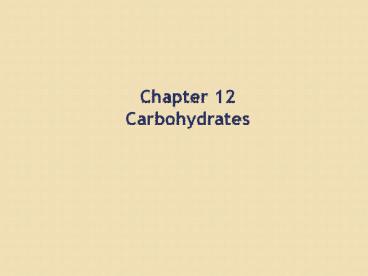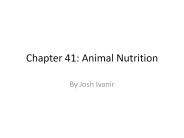Chapter 12 Carbohydrates
1 / 54
Title: Chapter 12 Carbohydrates
1
Chapter 12 Carbohydrates
2
Carbohydrates
- Carbohydrate A polyhydroxyaldehyde or
polyhydroxyketone, or a substance that gives
these compounds on hydrolysis. - Monosaccharide A carbohydrate that cannot be
hydrolyzed to a simpler carbohydrate. - Monosaccharides have the general formula CnH2nOn,
where n varies from 3 to 8. - Aldose A monosaccharide containing an aldehyde
group. - Ketose A monosaccharide containing a ketone
group.
3
Monosaccharides
- The suffix -ose indicates that a molecule is a
carbohydrate. - The prefixes tri-, tetra, penta, and so forth
indicate the number of carbon atoms in the chain. - Those containing an aldehyde group are classified
as aldoses. - Those containing a ketone group are classified as
ketoses. - There are only two trioses
4
Monosaccharides
- There are only two trioses
- Often aldo- and keto- are omitted and these
compounds are referred to simply as trioses. - Although triose does not tell the nature of the
carbonyl group, it at least tells the number of
carbons.
5
Monosaccharide
- Monosaccharides with
- three carbons trioses
- Five carbons pentose
- Six carbons hexose
- And so on
6
Monosacharides
- Figure 12.1 Glyceraldehyde, the simplest aldose,
contains one stereocenter and exists as a pair of
enantiomers.
7
Enantiomers
- Enantiomers a molecule has a nonsuperimposable
mirror image - Chiral molecule has four different groups
8
Monosaccharides
- Fischer projection A two-dimensional
representation for showing the configuration of
tetrahedral stereocenters. - Horizontal lines represent bonds projecting
forward from the stereocenter. - Vertical lines represent bonds projecting to the
rear. - Only the stereocenter is in the plane.
(R)-Glyceraldehyde (3-D representation)
(R)-Glyceraldehyde (Fisher projection)
9
Monosacharides
- In 1891, Emil Fischer made the arbitrary
assignments of D- and L- to the enantiomers of
glyceraldehyde. - D-monosaccharide the OH is attached to the
bottom-most assymetric center (the carbon that is
second from the bottom) is on the right in a
Fischer projection.
10
Monosacharides
- L-monosaccharide the -OH is on the left in a
Fischer projection.
11
Table 12.1
Table 20-1 p532
12
Table 12.2
Table 20-2 p532
13
Examples
- Draw Fisher projections for all 2-ketopentoses.
Which are D-2-ketopentoses, which are
L-2-ketopentoses? Prefer to table 12.2 (your
textbook) to write their names
14
Amino Sugars
- Amino sugars contain an -NH2 group in place of
an -OH group. - Only three amino sugars are common in nature
D-glucosamine, D-mannosamine, and
D-galactosamine. N-acetyl-D-glucosamine is an
acetylated derivative of D-glucosamine.
15
Cyclic Structure
- Aldehydes and ketones react with alcohols to form
hemiacetals - Cyclic hemiacetals form readily when the hydroxyl
and carbonyl groups are part of the same molecule
and their interaction can form a five- or
six-membered ring.
16
Epimers
- Diastereomers that differ in configuration at
only on asymmetric center
17
Haworth Projections
- Figure 12.2 D-Glucose forms these two cyclic
hemiacetals.
Same side
D-glucose
?-D-Glucopyranose ß-D-Glucose
?-D-Glucopyranose ?-D-glucose
18
Haworth Projections
- A five- or six-membered cyclic hemiacetal is
represented as a planar ring, lying roughly
perpendicular to the plane of the paper. - Groups bonded to the carbons of the ring then lie
either above or below the plane of the ring. - The new carbon stereocenter created in forming
the cyclic structure is called the anomeric
carbon. - Stereoisomers that differ in configuration only
at the anomeric carbon are called anomers. - The anomeric carbon of an aldose is C-1 that of
the most common ketose is C-2.
19
Haworth Projections
- In the terminology of carbohydrate chemistry,
- A six-membered hemiacetal ring is called a
pyranose, and a five-membered hemiacetal ring is
called a furanose because these ring sizes
correspond to the heterocyclic compounds furan
and pyran.
20
Haworth Projections
- Aldopentoses also form cyclic hemiacetals.
- The most prevalent forms of D-ribose and other
pentoses in the biological world are furanoses. - The prefix deoxy means without oxygen. at C2
?-D-Ribofuranose ?-D-Ribose
ß-2-Deoxy-D-ribofuranose ?-2-Deoxy-D-ribose
21
Haworth Projections
- D-Fructose (a 2-ketohexose) also forms a
five-membered cyclic hemiacetal.
?-D-Fructofuranose ?-D-Fructose
D-Fructose
ß-D-Fructofuranose ß-D-Fructose
22
Examples
- Give structure of the cyclic hemiacetal formed by
- 4-hydroxybutanal
- 5-hydroxypentanal
23
Chair Conformations
- For pyranoses, the six-membered ring is more
accurately represented as a strain-free chair
conformation.
ß-D-Glucopyranose
?-D-Glucopyranose
D-Glucose
24
Chair Conformations
- In both Haworth projections and chair
conformations, the orientations of groups on
carbons 1- 5 of b-D-glucopyranose are up, down,
up, down, and up.
25
Chair Conformations
26
Examples
- Which OH groups are in the axial position in
- ß-D-mannopyranose
- ß-D-idopyranose
27
Mutarotation
- Mutarotation The change in specific rotation
that accompanies the equilibration of a- and
b-anomers in aqueous solution. - Example When either a-D-glucose or b-D-glucose
is dissolved in water, the specific rotation of
the solution gradually changes to an equilibrium
value of 52.7, which corresponds to 64 beta
and 36 alpha forms.
ß-D-Glucopyranose
D-Glucose
ß-D-Glucopyranose
?-D-Glucopyranose
28
Formation of Glycosides
- Treatment of a monosaccharide, all of which exist
almost exclusively in cyclic hemiacetal forms,
with an alcohol gives an acetal.
Glycosidic bond
Glycosidic bond
ß-D-Glucopyranose ß-D-Glucose
Methyl ß-D-glucopyranoside Methyl ß-D-glucoside
Methyl ?-D-glucopyranoside Methyl ?-D-glucoside
29
Formation of Glycosides
- A cyclic acetal derived from a monosaccharide is
called a glycoside. - The bond from the anomeric carbon to the -OR
group is called a glycosidic bond. - Mutarotation is not possible for a glycoside
because an acetal, unlike a hemiacetal, is not in
equilibrium with the open-chain
carbonyl-containing compound.
30
Formation of Glycosides
- Glycosides are stable in water and aqueous base,
but like other acetals, are hydrolyzed in aqueous
acid to an alcohol and a monosaccharide. - Glycosides are named by listing the alkyl or aryl
group bonded to oxygen followed by the name of
the carbohydrate in which the ending -e is
replaced by -ide.
31
Examples
- Draw a Haworth projection and a chair
conformation for methyl ?-D-mannopyranoside.
Label the anomeric carbon and glycosidic bond
32
Reduction to Alditols
- The carbonyl group of a monosaccharide can be
reduced to an hydroxyl group by a variety of
reducing agents, including NaBH4 and H2 in the
presence of a transition metal catalyst. - The reduction product is called an alditol.
- Alditols are named by changing the suffix -ose to
-itol
33
Alditols
- The product formed when the CHO group of
monosaccharide is reduced to CH2OH group
- Sorbitol is found in the plant world in many
berries and in cherries, plums, pears, apples,
seaweed, and algae. - It is about 60 percent as sweet as sucrose (table
sugar) and is used in the manufacture of candies
and as a sugar substitute for diabetics.
34
Alditols
- These three alditols are also common in the
biological world. Note that only one of these is
chiral.
Erythritol
D-Mannitol
Xylitol
35
Oxidation to Aldonic Acids
- The aldehyde group of an aldose is oxidized under
basic conditions to a carboxylate anion. - The oxidation product is called an aldonic acid.
- A carbohydrate that reacts with an oxidizing
agent to form an aldonic acid is classified as a
reducing sugar (it reduces the oxidizing agent). - Itself is being oxidized
36
Oxidation to Aldonic Acids
- 2-Ketoses (e.g. D-fructose) are also reducing
sugars.
37
Oxidation to Aldonic Acids
ß-D-Glucopyranose
D-Glucose
D-Gluconate an aldonic acid
38
Oxidation to Aldonic Acids
- The body uses glucuronic acid to detoxify foreign
alcohols and phenols. - These compounds are converted in the liver to
glycosides of glucuronic acid and then excreted
in the urine. - The intravenous anesthetic propofol is converted
to the following water-soluble glucuronide and
excreted.
39
Formation of Phosphoric esters
40
What are Disaccharides and Oligosaccharides?
- Disaccharide A carbohydrate containing two
monosaccharide units joined by a glycosidic bond - Oligosaccharide A carbohydrate containing from
six to ten monosaccharide units, each joined to
the next by glycosidic bond - Polysaccharide A carbohydrate consisting of
large numbers of monosaccharide units joined by
glycosidic bonds.
41
Sucrose
- Table sugar, obtained from the juice of sugar
cane and sugar beet.
?-1,2-Glycosidic bond
Sucrose
42
Lactose
- The principle sugar present in milk.
- About 5 - 8 in human milk, 4 - 5 in cows milk.
- Has no sweetness
ß-1,4-Glycosidic bond
ß-1,4-Glycosidic bond
Lactose
43
Maltose
- From malt, the juice of sprouted barley and other
cereal grains.
?-1,4-Glycosidic bond
Maltose
44
Polysaccharides
- Starch A polymer of D-glucose.
- Starch can be separated into amylose and
amylopectin. - Amylose is composed of unbranched chains of up to
4000 D-glucose units joined by a-1,4-glycosidic
bonds. - Amylopectin contains chains up to 10,000
D-glucose units also joined by a-1,4-glycosidic
bonds at branch points, new chains of 24 to 30
units are started by a-1,6-glycosidic bonds.
45
Polysaccharides
- Figure 12.3 Amylopectin is a branched polymer of
D-glucose units joined by a-1,4-glycosidic bonds.
Branches consist of D-glucose units that start
with an a-1,6-glycosidic bond.
?-1,6-Glycosidic bond
?-1,4-Glycosidic bonds
46
Polysaccharides
- Glycogen is the energy-reserve carbohydrate for
animals. - Glycogen is a branched polysaccharide of
approximately 106 glucose units joined by a-1,4-
and a-1,6-glycosidic bonds. - The total amount of glycogen in the body of a
well-nourished adult human is about 350 g,
divided almost equally between liver and muscle.
47
Polysaccharides
- Cellulose is a linear polysaccharide of
D-glucose units joined by b-1,4-glycosidic bonds. - It has an average molecular weight of 400,000
g/mol, corresponding to approximately 2200
glucose units per molecule. - Cellulose molecules act like stiff rods and align
themselves side by side into well-organized
water-insoluble fibers in which the OH groups
form numerous intermolecular hydrogen bonds. - This arrangement of parallel chains in bundles
gives cellulose fibers their high mechanical
strength. - It is also the reason why cellulose is insoluble
in water.
48
Polysaccharides
- Figure 12.4 Cellulose is a linear polysaccharide
of D-glucose units joined by b-1,4-glycosidic
bonds.
ß-1,4-Glycosidic bonds
49
Polysaccharides
- Cellulose (contd)
- Humans and other animals can not digest cellulose
because their digestive systems do not contain
b-glycosidases, enzymes that catalyze the
hydrolysis of b-glycosidic bonds. - Termites have such bacteria in their intestines
and can use wood as their principal food. - Ruminants (cud-chewing animals) and horses can
also digest grasses and hay. - Humans have only a-glucosidases hence, the
polysaccharides we use as sources of glucose are
starch and glycogen. - Many bacteria and microorganisms have
b-glucosidases.
50
Example
- Draw a chair conformation for a disaccharide in
which two units of D-glucopyranose are joined by
a ß -1,3-glycosidic bond
51
Acidic Polysaccharides
- Acidic polysaccharides a group of
polysaccharides that contain carboxyl groups
and/or sulfuric ester groups, and play important
roles in the structure and function of connective
tissues. - There is no single general type of connective
tissue. - Rather, there are a large number of highly
specialized forms, such as cartilage, bone,
synovial fluid, skin, tendons, blood vessels,
intervertebral disks, and cornea. - Most connective tissues are made up of collagen,
a structural protein, in combination with a
variety of acidic polysaccharides.
52
Acidic Polysaccharides
- Heparin (contd)
- Heparin is synthesized and stored in mast cells
of various tissues, particularly the liver,
lungs, and gut. - The best known and understood of its biological
functions is its anticoagulant activity. - It binds strongly to antithrombin III, a plasma
protein involved in terminating the clotting
process.
53
Heparin
- Figure 12.5 The repeating pentasaccharide unit of
heparin.
54
p546































